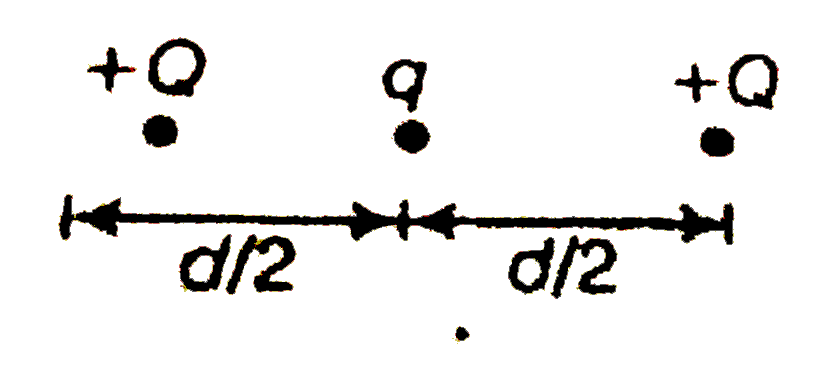Two negative point charges each of magnitude 2 esu and another point charge q are lying on a straight line. Each of the charges are in equilibrium. Determine the position, value and the nature of the charge q.Solution in Bengali
Since the two negative charges and the another charge q are in a straight line and in equilibrium, then the charge q must be positive. Also the charge q should be placed in between the two negative charges such that the resultant force acting on q due to the two negative charges becomes zero.
From Fig the two 2 esu charges are placed at points A and B respectively and charge q is placed at point C.

Let AB=r and AC=x
Now the attractive force acting on +q due to the negative charge at A=q×2x2
and the attractive force acting on +q due to the negative charge at B=q×2(r−x)2
Now from the condition of equilibrium of charge q
q×2x2=q×2(r−x)2 or x=r2
Again the resulsive force between the charge at A and B will try to push them apart but the positive charge at C will attract them and maintain the equilibrium. Then the attractive force acting on any of the negative charge due to the positive charge q, must be equal to the force of repulsion betwen two negative charges.
∴q×2(r2)2=2×2r2 or q=12=0.5 esu
Topper's Solved these Questions
- BOOK - CHHAYA PUBLICATIONCHAPTER - ELECTRIC FIELDEXERCISE - SECTION RELATION QUESTIONS50videos
ELECTRIC FIELD
- BOOK - CHHAYA PUBLICATIONCHAPTER - ELECTRIC FIELDEXERCISE - HIGHER ORDER THINKING SKILL QUESTIONS33videos
ELECTRIC FIELD
- BOOK - CHHAYA PUBLICATIONCHAPTER - ELECTRIC ENERGY AND POWEREXERCISE - CBSE SCANNER7videos
ELECTRIC ENERGY AND POWER
- BOOK - CHHAYA PUBLICATIONCHAPTER - ELECTRIC POTENTIAL EXERCISE - CBSE Scanner13videos
ELECTRIC POTENTIAL
Similar Questions
State Coulomb's law regarding the force of interaction between two point charge. Define the unit of charge from this law.
02:33View SolutionTwo charges, +qand−q are separated by a distance d. At which points will the resultant electric field intensity be directed parallel to the line joining the charges ?
03:48View SolutionA light bulb is rated 100 W for 220 V ac supply of 50 Hz. Calculate
the resistance of the bulb ,05:19View SolutionA test charge q is moved without acceleration along the path from A to B from B to C in electric field E as shown in fig.

(i) Calculate the potential difference between A and C.07:02View SolutionTwo negative charges of a unit magnitude and a positive charge q are placed along a straight line. At what position and value of q will the system be in equilibrium? (Negative charges are fixed).
08:29View SolutionTwo positive point charges , each Q , are fixed at separation d . A third charge q is placed in the middle. Describe the equilibrium of the third charge.
08:17View SolutionTwo positively charged particles each having charge Q and are d distance apart. A third charge is introduced in midway on the line joining the two charges. Find the nature and magnitude of third charge so that the system is in equilibrium.
 06:38View Solution
06:38View Solution(a) Derive and expression for the electric field at any point on the equatorial line of an electric dipole.
(b) Two identical point charges, q each kept 2m apart in air. A third point charge Q of unknown magnitude and sign is placed on the line joining the charges such that the system remains in equilibrium. Find the position and nature of Q.04:27View Solutionदो आवेश q तथा + 4q एक-दूसरे से d दूरी पर हैं। एक अन्य आवेश Q को दोनों आवेशों के मिलाने वाली रेखा पर इस प्रकार रखया जाता है कि तौनों आवेश सन्तुलन में रहते हैं। आवेश Q का मान तथा इसकी स्थिति ज्ञात कीजिए।
09:24View SolutionTwo negative charges each of 1 unit and a positive charge q are placed along a straight line. Find the magnitude and position of q for which all the chargews will remain at equilibrium? Is the equilibrium stable, unstable or neutral in this case?
04:17View SolutionTwo negative charges each of 1 unit and a positive charge q are placed on a straight line. Where should the charge q be placed and what should be its value for equilibrium of the charges? Is this equilibrium stable, unstable or neutral ?
10:39View SolutionTwo unit negative charges placed on a straight line. A positive charge q is placed exactly at the mid point between these unit charges. If the system of these three charges is in equilibrium, the value of q (in C) is
03:47View SolutionTwo positive point charges Q and one negative point charge q are arranged in a straight line in such a manner that the complete system remains in equilibrium. What can be the magnituude of Q/q ?
03:21View SolutionTwo point-charges A and B whose charge amounts are + q and + 4q respectively at a distance of a in a straight line. A third charge Q is placed in such a way that the charges are in equilibrium. The third will be the position of the charge
05:11View Solution1 unit মানের দুটি ঋণাত্মক আধান ও একটি ধনাত্মক আধান q একই সরলরেখায় অবস্থিত । q আধানটিকে কোথায় স্থাপন করলে এবং সেটির মান কত হলে আধানগুলি সাম্যবস্থায় থাকবে ? এই সাম্য কিরূপ - সুস্থির , অস্থির , না নিরপেক্ষ ?
05:06View Solution

